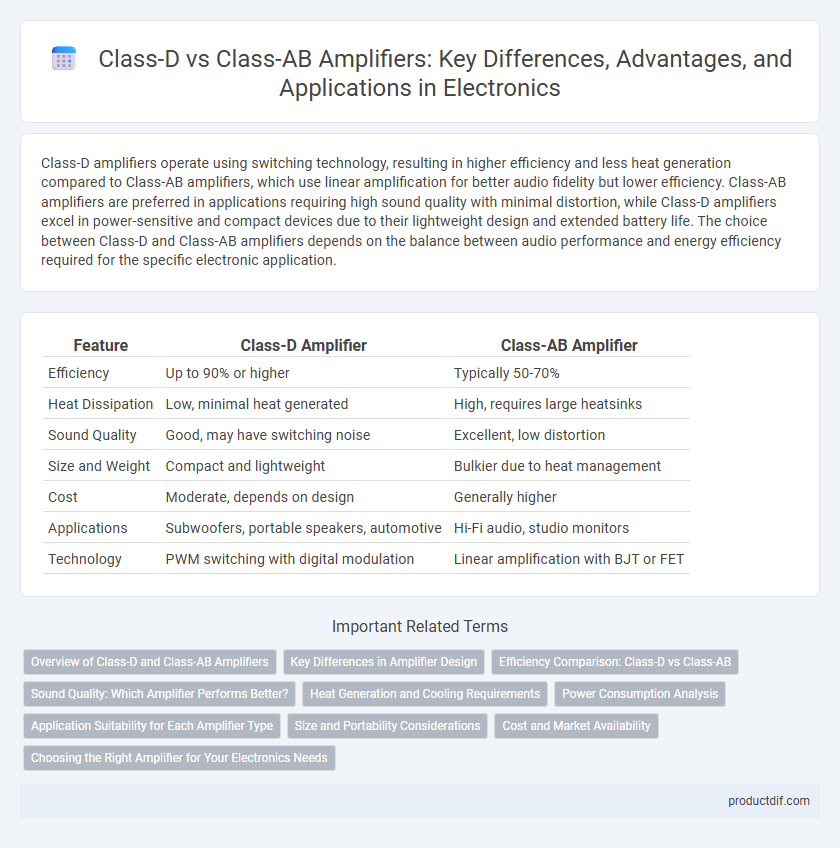Class-D amplifiers operate using switching technology, resulting in higher efficiency and less heat generation compared to Class-AB amplifiers, which use linear amplification for better audio fidelity but lower efficiency. Class-AB amplifiers are preferred in applications requiring high sound quality with minimal distortion, while Class-D amplifiers excel in power-sensitive and compact devices due to their lightweight design and extended battery life. The choice between Class-D and Class-AB amplifiers depends on the balance between audio performance and energy efficiency required for the specific electronic application.
Table of Comparison
| Feature | Class-D Amplifier | Class-AB Amplifier |
|---|---|---|
| Efficiency | Up to 90% or higher | Typically 50-70% |
| Heat Dissipation | Low, minimal heat generated | High, requires large heatsinks |
| Sound Quality | Good, may have switching noise | Excellent, low distortion |
| Size and Weight | Compact and lightweight | Bulkier due to heat management |
| Cost | Moderate, depends on design | Generally higher |
| Applications | Subwoofers, portable speakers, automotive | Hi-Fi audio, studio monitors |
| Technology | PWM switching with digital modulation | Linear amplification with BJT or FET |
Overview of Class-D and Class-AB Amplifiers
Class-D amplifiers operate using pulse-width modulation, enabling high efficiency often above 90%, making them ideal for portable and battery-powered electronics. Class-AB amplifiers combine the low distortion of Class-A with the efficiency of Class-B, offering a balanced output suitable for high-fidelity audio applications. While Class-AB provides superior linearity and lower harmonic distortion, Class-D excels in power efficiency and compact size, influencing their respective usage in audio electronics.
Key Differences in Amplifier Design
Class-D amplifiers utilize pulse-width modulation to achieve high efficiency, minimizing power loss through switching transistors operating as digital switches. Class-AB amplifiers combine the linear amplification of Class-A with the efficiency of Class-B by using transistors that conduct more than half the input signal cycle, resulting in moderate distortion and heat generation. Key design differences include Class-D's reliance on digital switching for compact size and energy savings versus Class-AB's analog linear operation providing superior audio fidelity but with greater power consumption.
Efficiency Comparison: Class-D vs Class-AB
Class-D amplifiers achieve efficiency levels typically above 90% by employing pulse-width modulation and switching output transistors fully on or off, minimizing power dissipation. In contrast, Class-AB amplifiers generally operate with efficiency around 50-70% due to their linear operation, where output transistors conduct simultaneously, causing higher heat generation. The superior efficiency of Class-D makes it ideal for battery-powered and thermal-sensitive applications, whereas Class-AB offers better linearity and audio fidelity at the expense of greater energy loss.
Sound Quality: Which Amplifier Performs Better?
Class-AB amplifiers typically offer superior sound quality with lower distortion and a more natural audio reproduction due to their linear amplification design. Class-D amplifiers, while highly efficient and capable of delivering high power output with minimal heat, may introduce switching noise and harmonic distortion that can affect sound fidelity. Advances in Class-D technology, such as improved modulation techniques and filtering, have narrowed the gap, but audiophiles generally prefer Class-AB for critical listening applications.
Heat Generation and Cooling Requirements
Class-D amplifiers generate significantly less heat compared to Class-AB amplifiers due to their high efficiency, often exceeding 90%, resulting in minimal power loss as heat. In contrast, Class-AB amplifiers typically operate at 50-70% efficiency, causing substantial heat dissipation and necessitating larger heat sinks or active cooling solutions. This difference in thermal output influences cooling system design, making Class-D preferred for compact, thermally constrained electronics.
Power Consumption Analysis
Class-D amplifiers exhibit significantly lower power consumption than Class-AB amplifiers due to their switching operation, which minimizes energy loss during signal amplification. Efficiency rates for Class-D amplifiers typically range from 85% to 95%, whereas Class-AB amplifiers usually operate between 50% and 70%, resulting in higher thermal dissipation. This efficiency advantage makes Class-D amplifiers the preferred choice for battery-powered and energy-sensitive electronic devices.
Application Suitability for Each Amplifier Type
Class-D amplifiers offer high efficiency and compact size, making them ideal for battery-powered devices, portable speakers, and automotive audio systems where power conservation and heat dissipation are critical. Class-AB amplifiers deliver superior linearity and lower distortion, which suits professional audio equipment, high-fidelity home audio systems, and musical instrument amplifiers requiring precise sound reproduction. Choosing between Class-D and Class-AB depends on balancing efficiency needs with audio quality demands specific to the application.
Size and Portability Considerations
Class-D amplifiers offer significantly smaller size and lighter weight due to their high efficiency and minimal heat dissipation, making them ideal for portable electronics and compact audio devices. Class-AB amplifiers, while delivering superior audio fidelity, are bulkier and require larger heat sinks, which limits their portability. The compact design of Class-D amplifiers enables integration into mobile devices, headphones, and automotive systems where size and power efficiency are critical.
Cost and Market Availability
Class-D amplifiers generally offer a more cost-effective solution due to their higher efficiency and simpler heat management, making them widely available in consumer electronics markets. Class-AB amplifiers, while typically more expensive because of their linear design and higher power dissipation, remain preferred in high-fidelity audio segments despite limited cost competitiveness. The broader market availability of Class-D amps is driven by increasing demand for compact, energy-efficient devices in portable and automotive audio systems.
Choosing the Right Amplifier for Your Electronics Needs
Class-D amplifiers offer higher efficiency and generate less heat, making them ideal for battery-powered and compact electronics. Class-AB amplifiers deliver superior audio fidelity and lower distortion, suitable for high-quality audio systems and professional sound applications. Selecting the right amplifier depends on balancing power efficiency needs against audio performance requirements in your electronic device.
Class-D vs Class-AB Amplifier Infographic

 productdif.com
productdif.com